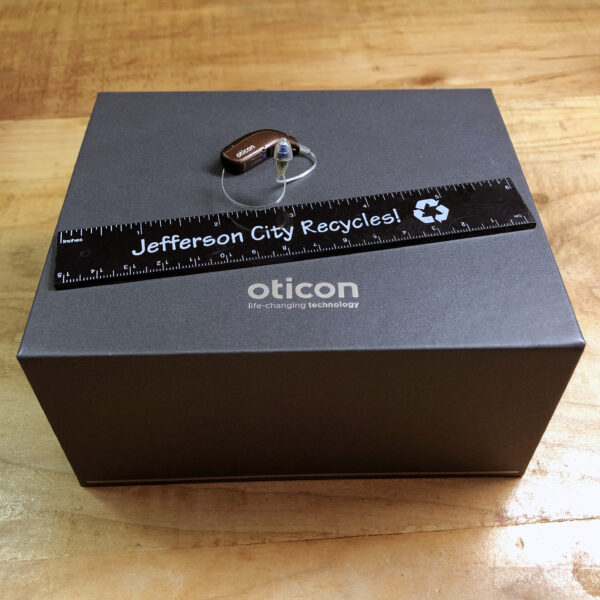For hemifacial spasm patients like myself, encroaching blood vessels disrupt the function of the myelin sheath surrounding the seventh (facial) cranial nerve. For patients with an acoustic neuroma, a tumor infringes on the eighth (hearing/balance) cranial nerve. In one of life’s little ironies, because these nerves lie in such close proximity, patients who have surgery to remove an acoustic neuroma are more likely to end up with facial paralysis than those who undergo microvascular decompression for hemifacial spasm.
I don’t know if the reverse is also true, but in addition to facial paralysis I woke up from surgery stone deaf in my left ear. I also had a strange tinnitus (ringing) that would grow alternatively louder and softer, like a lawnmower circling a big tree. My neurosurgeon explained that my brain was trying to make sense of the sudden silence, and although he was pessimistic about my hearing, suggested that I consult with an audiologist in a few weeks. He also warned me that my balance might also be affected (although that never turned out to be an issue other than slight vertigo around moving water).
Fortunately, the tinnitus subsided, and I slowly regained some hearing. After six weeks, an audiogram showed moderate low-frequency hearing loss in my left ear, with 85% word recognition at conversational volume, falling to 64% at higher decibels. Word recognition on the right side was 100%. I was told that this level of loss did not qualify for a hearing aid, and the audiologist recommended a followup in a year.
Two weeks later, a second audiogram by a facial nerve specialist dovetailed the findings of the first one, showing low-frequency hearing loss and 84% word recognition. Hearings aids were not mentioned, in fact, he was optimistic that I might regain full hearing. A few months later at a Christmas party I chatted with a Beltone representative, who confirmed that hearing aids are not generally prescribed for that level of hearing loss.
I began to develop mechanisms for coping with the slight hearing loss. I switched from holding the phone to my left ear to the right. I adjusted the balance on my computer speakers and headphones more toward the left. In face-to-face conversations I positioned the speaker to my right whenever possible. These techniques worked so well that I forgot all about scheduling a audiogram follow-up after a year. Or two … or five … or ten.
Last fall, after fifteen years, I noticed subtle changes in my hearing — I was asking people to repeat themselves more often and I wasn’t asking my husband to turn down the television volume quite so much. I mentioned this during an ENT consult for an unrelated sinus issue, and was referred for an audiogram. That test showed that the hearing loss in my left ear had progressed to “moderate to severe” and both ears showed typical age-related mild upper-frequency hearing loss. Word recognition had fallen to 64% on the left, but remained at 100% on the right.
The audiologist informed me that research in the years since my hearing loss indicates that speech recognition deficits become permanent over time. While there is no way to know when my word recognition scores began to drop, treating the underlying hearing loss can keep it from falling any lower. She asked me how I felt about wearing a hearing aid. I told her that I do not view it any differently than wearing glasses to correct my vision, and I’ve done that since I was eight years old. I also told her I intend to be one of the data outliers and improve my word recognition score!
The audiologist fitted me with an Oticon Real 1 miniRITE R. Because my right side word recognition is still 100% I do not need a second hearing aid at this time. I opted for the rechargeable version of the hearing aid and the travel-friendly rechargeable charging station. (It is advertised to last three nights on a single charge, but I discovered it extends to six nights for a single hearing aid.)
Hearing aids can be programmed for different environments and controlled via a smartphone app. In fact, phone calls, music and television programs can be streamed through hearing aids just as though they are wireless earbuds. I opt not to stream, mainly because the hearing in my left ear sounds like it comes through a long tunnel. If I were able to split input between a hearing aid and an earbud I might consider it, but that is not possible at this time. My hearing aid is programmed with General, Comfort, Speech in Noise, and Music programs, and has been further customized using Real Ear Measurement testing. Most days I start out in the General program but switch over to the Comfort program. It seems to filter out more background sounds, especially road noise. While I do hear more with the hearing aid, I’m not yet convinced that I hear better. Maybe over time it will improve.
My daily routine entails inserting the hearing aid in the morning and taking it out at bedtime to charge, although I have been known to skip a day or to sleep with it. (Sadly, I’ve also been known to forget to remove it for showers or haircuts until the last possible moment.) Once a month I change the filter and dome that go into my ear canal, but fortunately my hearing requires much less time and maintenance and far fewer supplies than does my eyesight.

In December I am scheduled for a follow-up audiogram. I am hopeful that my word recognition will improve. I absolutely own my neglect in not scheduling follow ups during the past fifteen years, but I also wish the audiology clinic had reached out with reminders. It’s not like gastroenterology ever forgets about scheduling colonoscopies!
